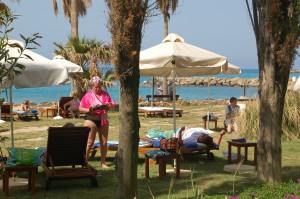SUNNY Cyprus was once a safe-haven for the English, a place where we felt at home because it was, after all, once ours. Ever since Lord Kitchener came here as a young engineer, the island has been subjected to merciless Anglicization which reached its peak in the mid-80s with the onset of mass tourism.
Brits flocked to Cyprus to work on their melanomas – then known as ‘tans’ – and enjoy the pubs and Indian and Chinese takeaways which sprouted along the coast. They bought homes on the coast and many settled down to enjoy the ex-pat way of life; bridge parties, tennis, St. George’s Day, Marmite famines, that sort of thing.
But now Cyprus is wooing a new breed. Russians, voted the world’s worst tourists in 2009, have invaded the beach resorts driving ‘nice’ British visitors to the brink of extinction. They are large, they are loud and like Germans (still clinging to their place as the world’s second worst tourists) they take over the sun loungers.
It’s all to do with the recession, apparently. Hotels such as Coral Bay in Paphos are struggling to fill their rooms so they offer vastly discounted all-inclusive deals to tour operators from places like Yakutsk in the Arctic Circle where the temperature averages -8 degrees centigrade and the 269,486 citizens all want to go to Cyprus. No wonder they are fat and like all Arctic creatures are programmed to eat everything they can find: they gorge on the buffets often carting extra plate loads to their rooms and stuffing their bags with bread rolls. It drives the staff mad.
Coral Bay hotel, where the British Olympic team often train, has also struck a deal with the French Foreign Legion which uses it as an R&R centre. The French are also way up there for being among the rudest tourists in the world and although the legionnaires look absolutely awesome in their Speedos, being woken to the sound of their workouts in the communal pool with the drill major shouting UN! DUH! TWA! CAT! CINK! … UN! DE! TWA! CAT! CINK! … UN! DE! TWA! CAT! CINK! is not conducive to relaxation.
The solution is to leave the coast alone these days. Drive into the countryside and visit some of the neglected villages of Cyprus. The roads are surprisingly good and thanks to Kitchener et al you drive on the left. Among the top attractions are the painted churches in the Troodos Mountains with their dazzling golden chandeliers and altar screens set with icons dating back to the 17 century. There are also monasteries with small signs saying ‘We Regret we are not Open to Tourists’ which have been painted over. Orthodox priests have abandoned a long tradition of isolation and opened their doors to the modern world. We visited Omodos, about 40km North West of Limassol, a picturesque village at the foothill of the Troodos Mountains, with the 17th century Monastery of the Holy Cross. Fully restored now, there’s also a small museum of lace and another with a fantastic collection of icons. It’s all open to the public, and free too. There’s no curator telling you not to touch anything and in fact many visitors bend to kiss the faces or hands of the painted saints. Ignorant? Perhaps it is. But having recently been ticked off at Tate Modern for breathing near a cabinet full of dead fish, I revelled in the lack of formality – and trust – displayed in Omodos.
Along with the Monastery of the Holy Cross, Omodos is famed for a particularly distinctive local wine called Afames made from local grapes. So great was its reputation that the guides tell you the Ottoman sultan Selim II conquered Cyprus just to get his hands on it. Other delicacies from Omodos are the almond pastes and jellies made from the sweet nuts of the trees whose pale pink blossoms are the
heralds of spring in the Troodos.
We searched in vain for The Walnut Tree restaurant which had been recommended and ended up instead in a tavern which one of Stalin’s granddaughters – I swear – now runs.
“Your camera schvized on, I put it off,” she announced as we sat down and clicked the dial on my Canon to off. We asked how long it would take to get to the Kykkos Monastery. “It is 50 kilometres, it take half hour. You have one hour for tour of monasterzy and one hour for town. You eatz then you go Kikkos monasterzy.”
We hung our heads and ordered what she told us to eatz. It seemed polite to do so, more English, and perhaps we would escape execution by her husband who was in the kitchen sharpening something.

